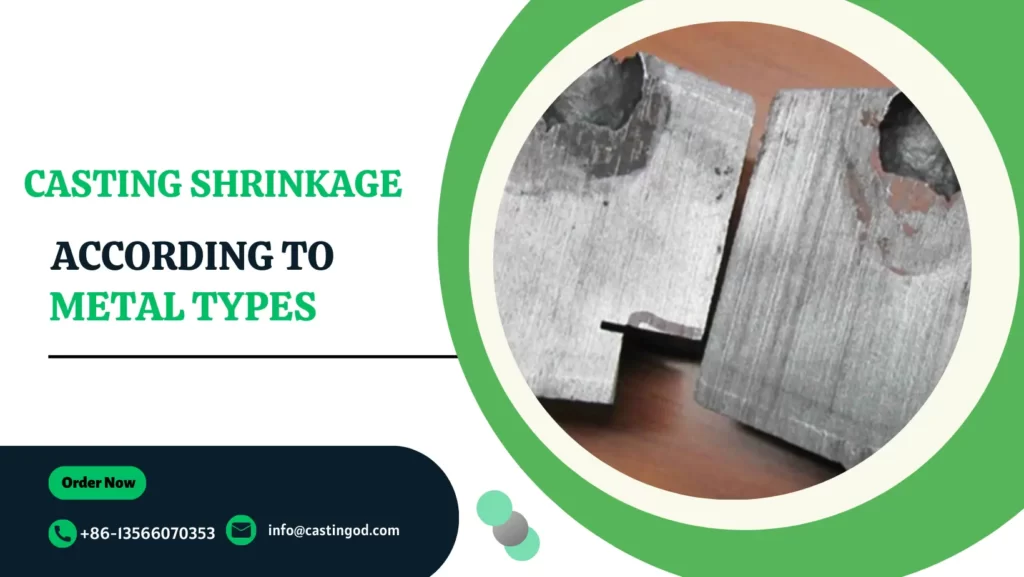Shrinkage is the reduction in volume and size of cast alloys. Metal, unlike water, shrinks as it cools and solidifies. This shrinkage can cause several defects, including:
Casting porosity:
Tiny air pockets resembling swiss cheese, often caused by trapped gas or insufficient feeding.
Shrinkage cavities:
Larger voids formed by the metal pulling away from the mold during solidification.
Hot tears:
Cracks caused by the metal pulling apart while still hot and weak.
Cold shuts:
Unfilled sections in the casting due to premature solidification before the mold is fully filled
Lets start from a very interesting question.
How to calculate shrinkage in casting?
According to casting shrinkage calculator, first gather following information:
First Step: Data Collection
1: Metal Type
2: Casting Method
3: Die Cast part Dimensions
2nd Step: Find The Shrinkage rate
Next step is to find shrinkage rate according to the casting method. You can see the different shrinkage variation in the following metal and casting process figure:
| Metal | Sand Casting (%) | Die Casting (%) | Investment Casting (%) | Lost Foam Casting (%) |
| Aluminum Alloys | 1.0 – 1.5 | 0.5 – 1.0 | 1.2 – 1.8 | 1.0 – 1.5 |
| Magnesium Alloys | 1.3 – 1.8 | 0.8 – 1.2 | 1.5 – 2.0 | 1.3 – 1.8 |
| Zinc Alloys | 0.8 – 1.2 | 0.3 – 0.7 | 1.0 – 1.5 | 0.8 – 1.2 |
| Copper Alloys | 1.0 – 1.5 | 0.8 – 1.2 | 1.2 – 1.8 | 1.0 – 1.5 |
| Cast Iron | 0.8 – 1.2 | 0.5 – 0.8 | 1.0 – 1.5 | 0.8 – 1.2 |
| Steel | 1.5 – 2.0 | 1.0 – 1.5 | 1.8 – 2.3 | 1.5 – 2.0 |
3rd Step: Calculate the shrinkage amount:
- Multiply the shrinkage rate by each linear dimension of your desired final size.
- Example: If your desired length is 10 cm and the shrinkage rate is 1.5%, the shrinkage amount would be 0.15 cm.
4th. Adjust your mold dimensions:
- Add the shrinkage amount to each linear dimension of your mold design.
- Example: If the desired length is 10 cm and the shrinkage is 0.15 cm, your mold length should be 10.15 cm.
Following video also provides practical steps to calculate shrinkage in casting parts.
Challenges of Casting Shrinkage According to Metal Type:

- Aluminum shrinks more than steel
- Casting process
- Sand casting vs. die casting
- The design of the part
It occurs mainly during the process of:
- Liquid condensation
- Cooling of this liquid at room temperature
Shrinkage in casting not only decreases size but also causes surface defects such as:
- Shrinkage cavities
- Porosity
- Internal stress
- Voids
- Cracks
As a result, casting materials with lower shrinkage rates perform better. Shrinkage has a direct effect on casting quality.
Shrinkage in Casting during Manufacturing
Moreover, shrinkage in casting also occurs during manufacturing because of the involvement of different processes, like:
- Pattern Making
- Core box making
- Molding
- Core Making
- Core setting
- Mold closing
- Melting
- Metal pouring
- Heat treatment
- Fettling
Generally, variations in these processes make it very hard to handle surface defects, even in a more monitored process.
Understanding the science of casting shrinkage is important to improving casting quality and dimensional accuracy. The following article provides an in-depth review of:
- What are the types of shrinkage in cast metals?
- How do different factors affect shrinkage?
- What are the strategies for mitigating shrinkage?
- Conclusion
3 Stages of Shrinkage in Cast Metals?
Shrinkage occurs in three different stages as molten metal cools:
Liquid Shrinkage
Liquid shrinkage occurs when an alloy cools while staying in its liquid state. This is not usually important in terms of casting design because additional alloy can be added to the mold via the risers.
Solidification Shrinkage (Liquid-To-Solid Shrinkage)
Solidification shrinkage is also called liquid-to-solid shrinkage. It usually occurs when an alloy goes from a liquid to a solid state. This is important for the designer because, during cooling, the mold’s fluid metal channels should stay open since contraction will force additional metal from the risers into the casting.
Solid Shrinkage
Solid-state shrinkage occurs after the solid metal casting cools down to room temperature. This is also important from a design perspective. It is also commonly referred to as “Patternmaker’s Shrinkage.” This needs to be taken into consideration while designing a mold or tooling to guarantee that the desired final dimensions are obtained.
7 Factors That Affect Shrinkage In Casting Metals

Multiple factors can affect cast metal shrinkage during the cooling and solidification processes. These factors must be considered to accurately calculate and modify shrinkage in casting designs. The following are some major factors that can affect shrinkage:
Mold Material
Casting mold material is an important factor. Different metal types possess distinct thermal conductivities, which impact the rate of heat moving from the molten metal to the mold. Most molten metals shrink when they solidify.
This can usually be 2-3% by volume for stainless steels and nickel alloys, 5-6% for copper alloys, and far greater for aluminum alloys.
Alloy’s Composition
The shrinkage rate of a metal alloy is greatly affected by its composition. Different alloys and their concentrations can affect the metal’s solidification behavior and overall shrinkage.
Cooling Rate
The rate of shrinkage is determined by how quickly the molten metal chills. Quick cooling causes more shrinkage, whereas slower cooling allows for controlled solidification and less shrinkage.
Mold Design
The mold’s dimensions and shape can affect how much the casting shrinks. The mold’s design must provide proper solidification without unnecessary surface defects caused by shrinkage.
Casting Methods
The casting methods used, like sand casting, investment casting, or die casting, can all have a direct effect on shrinkage. The cooling and solidification processes are affected by a unique set of conditions and parameters for each method.
Stress and Contraction
Internal metal stress and contraction are caused by phase transitions during solidification. These all lead to total shrinkage. Control and well-constructed structures can help reduce these effects.
How to Mitigate Shrinkage in Cast Metal?
Mitigating shrinkage in metal casting is vital to manufacturing high-quality and geometrically precise components. The following are useful strategies for reducing shrinkage in cast metal:
Shrinkage Allowance
- Understanding Shrinkage Allowance: Add a shrinkage allowance in the casting design. This means carefully oversizing the casting design to compensate for expected shrinkage during the process of solidification
- Accurate Calculation: Calculate the correct shrinkage allowance for the provided metal alloy, casting technique, and component dimensions. To improve your shrinkage allowance, review material data sheets, industry standards, and trials.
Risers and Feeders
- Improve the Riser Design: Add necessary risers to the casting layout. Risers serve as molten metal reservoirs. They ensure a constant supply to make up for shrinkage. Make sure risers are positioned properly and that their size fits with the geometry of the casting.
Control the cooling rate
- Controlled Cooling: During the casting process, adjust the rate of cooling to the behavior of directional solidification. Slower cooling rates can reduce shrinkage. To control the cooling rate and reduce total shrinkage, consider insulation, mold material, and preheating.
Simulation and Modeling
- Use software for casting simulation: Use computer-aided engineering (CAE) techniques to simulate and model casting processes. With the help of these tools, solidification performance and shrinkage patterns can be easily predicted. These tools enable design and process parameter changes before actual production.
Ensuring Quality
- Tight Inspection: Use strict quality control procedures, such as:
- Visual examination
- Dimension checks
- Non-destructive testing (ultrasonic or x-ray inspection)
Discover and remove castings that show considerable shrinkage or other related surface defects.
Conclusion

Knowing and controlling shrinkage factors is essential to achieving dimensional precision in cast metal components and avoiding flaws such as:
- Shrinkage cavities
- Porosity
- Warping
Various factors affect the shrinkage behavior, including:
- The alloy composition
- Cooling rate
- Casting method
- Mold design
Engineers and metallurgists improve the casting process and create superior metal castings by combining theoretical knowledge, practical expertise, and modern modeling strategies.








